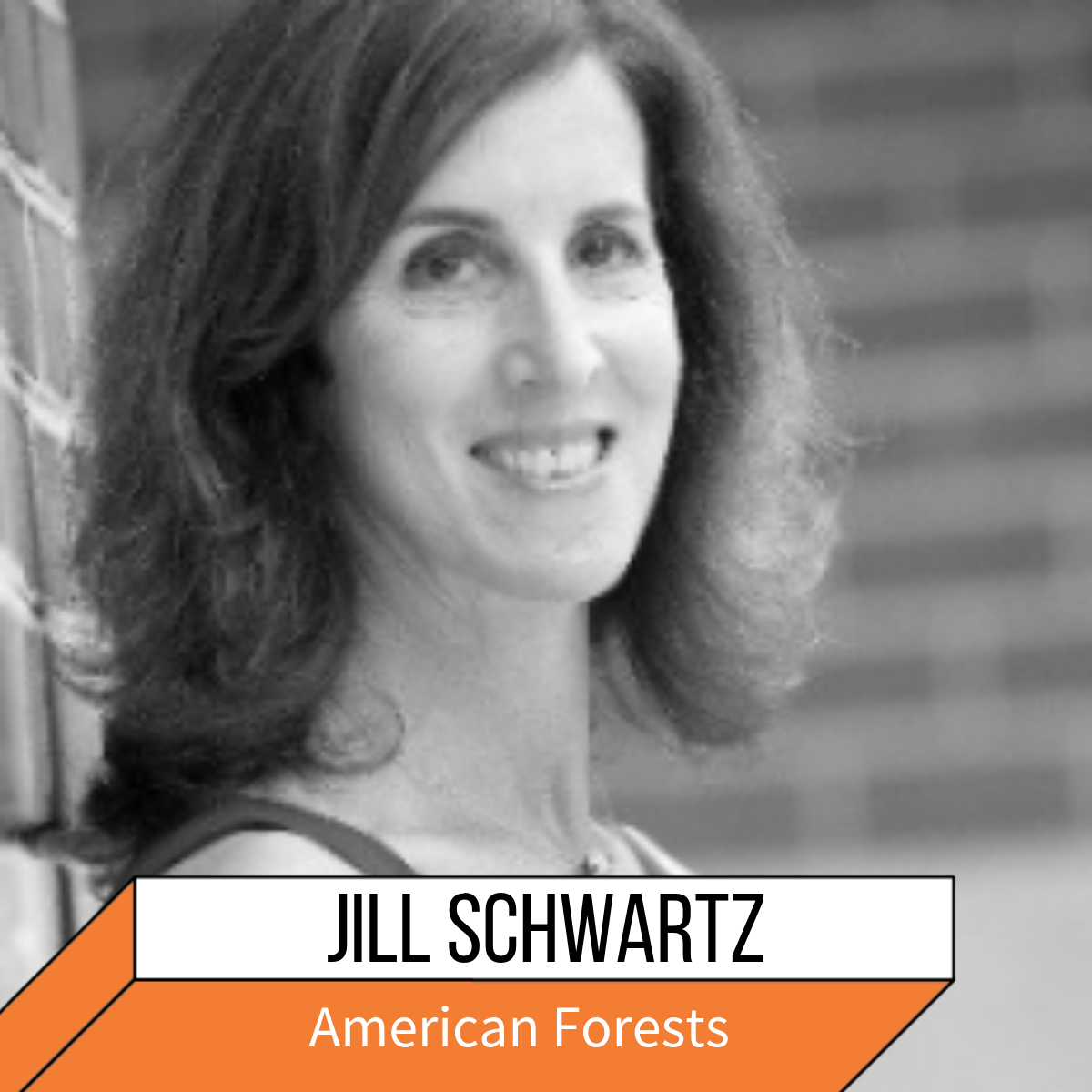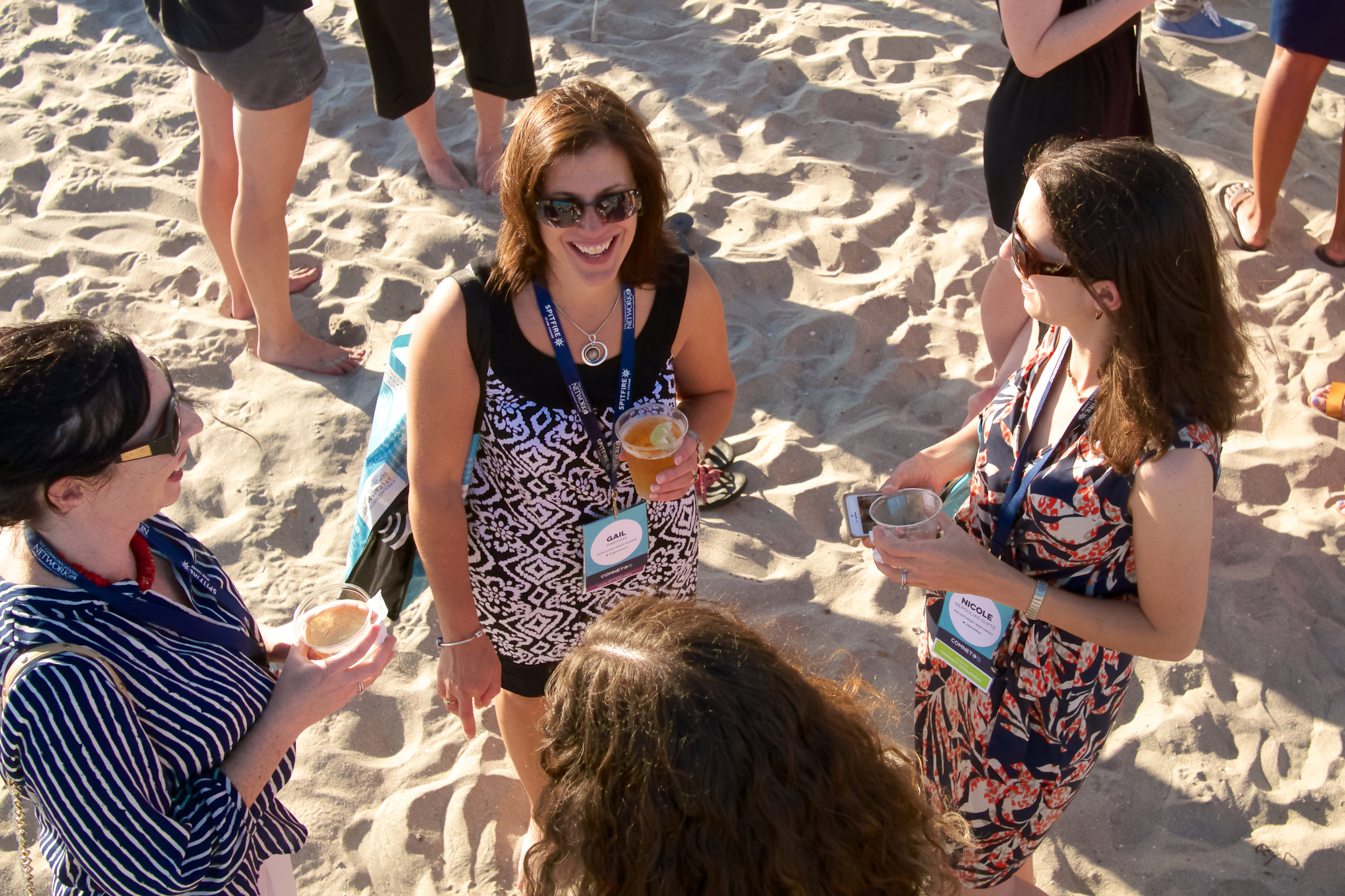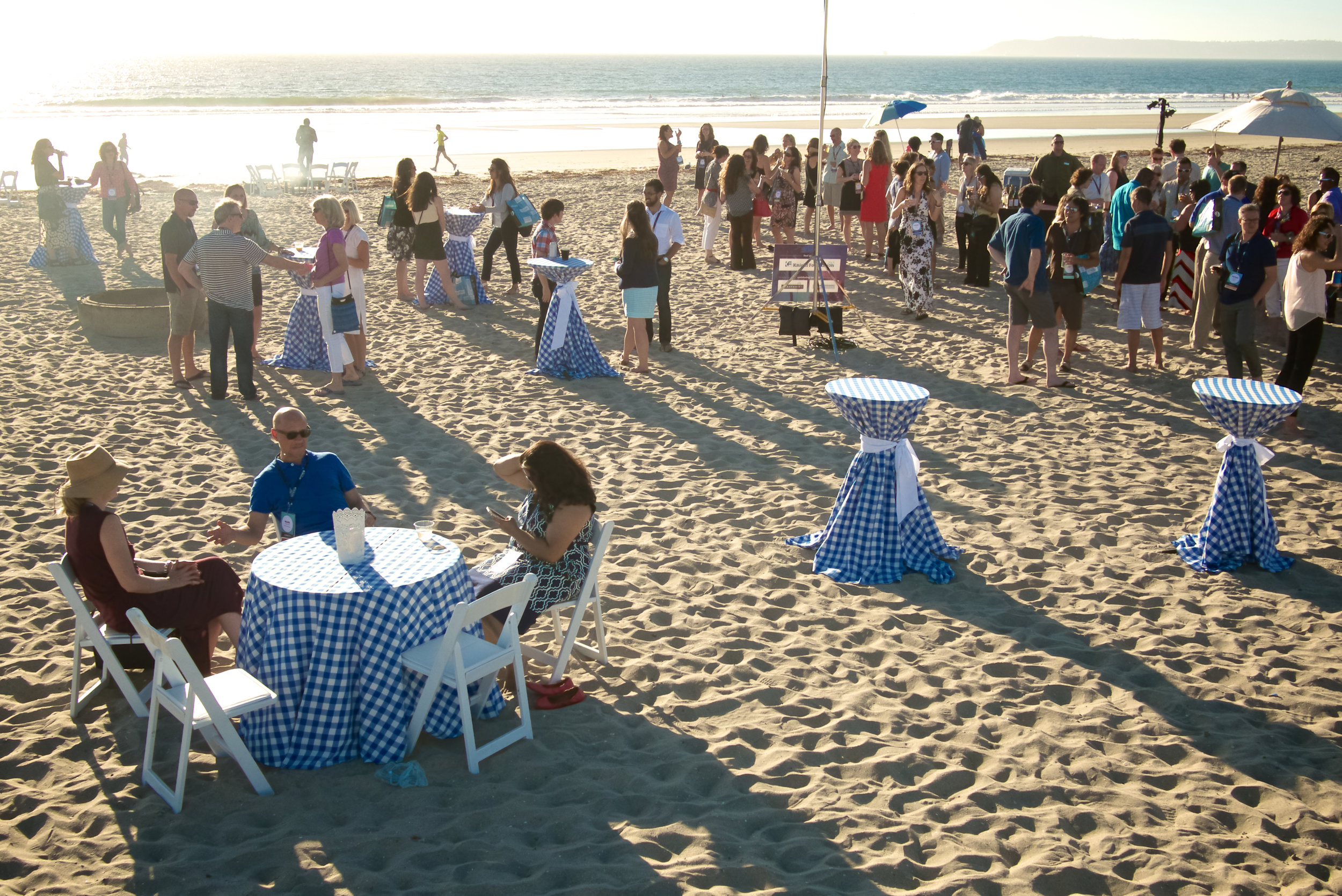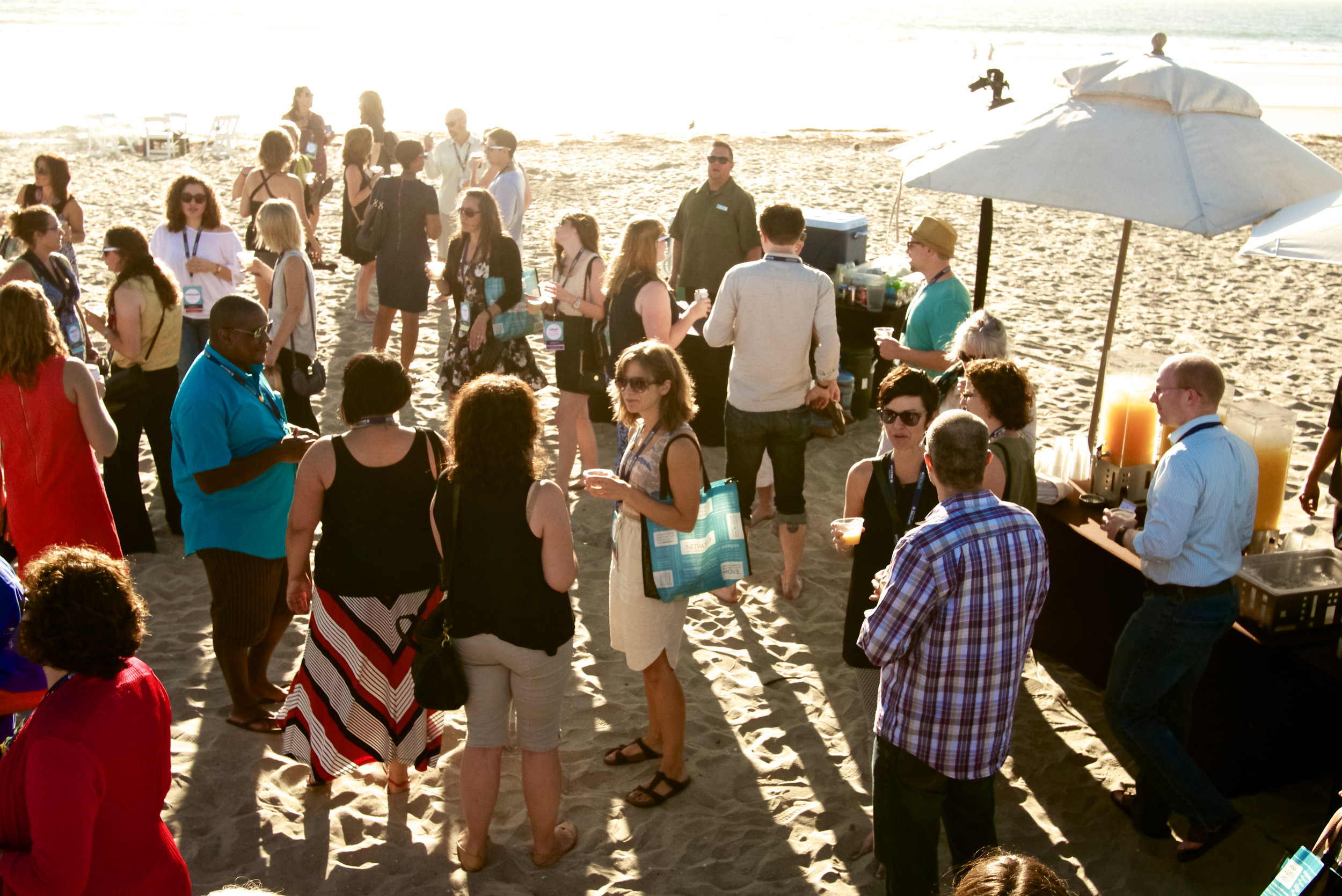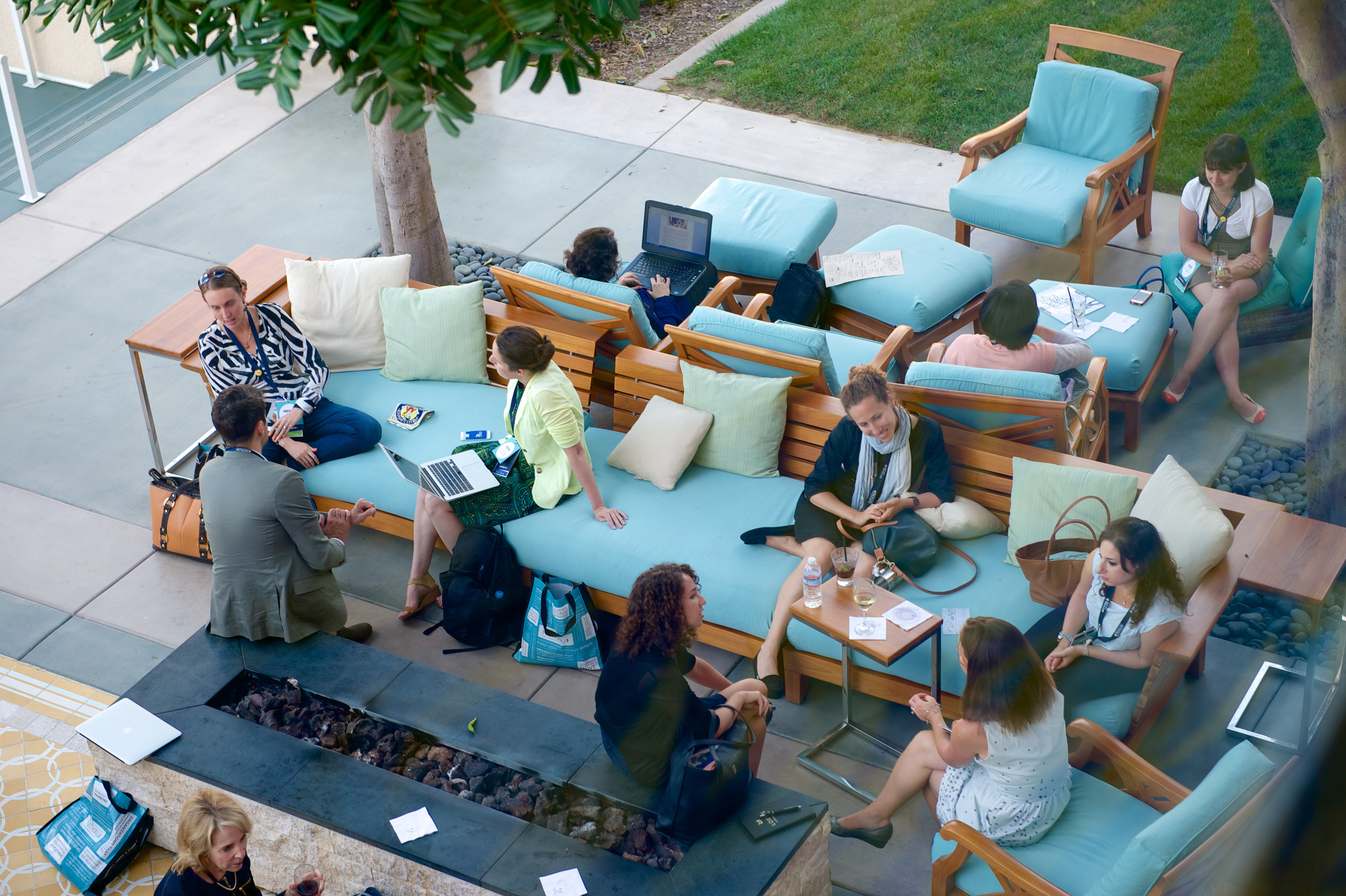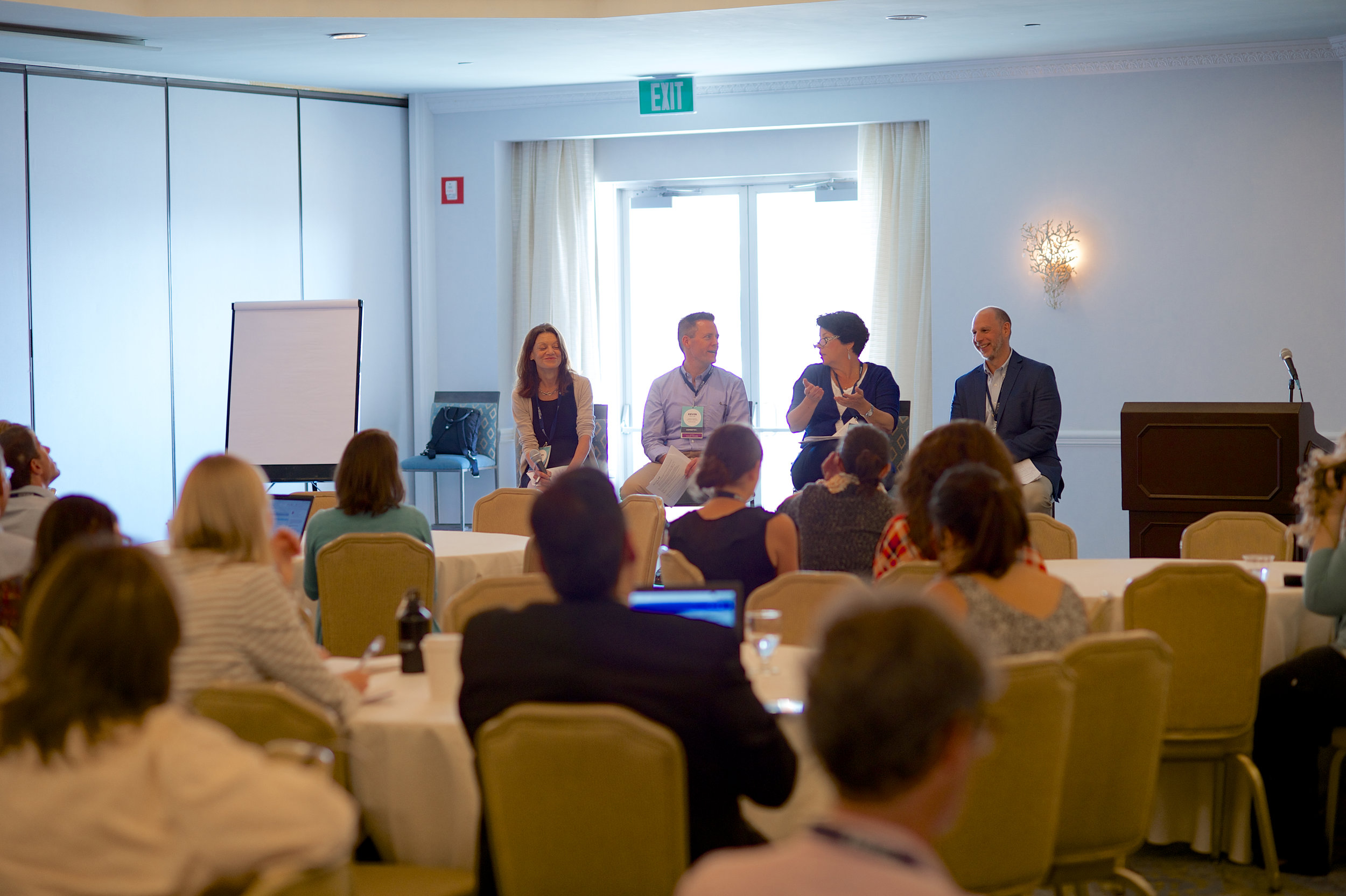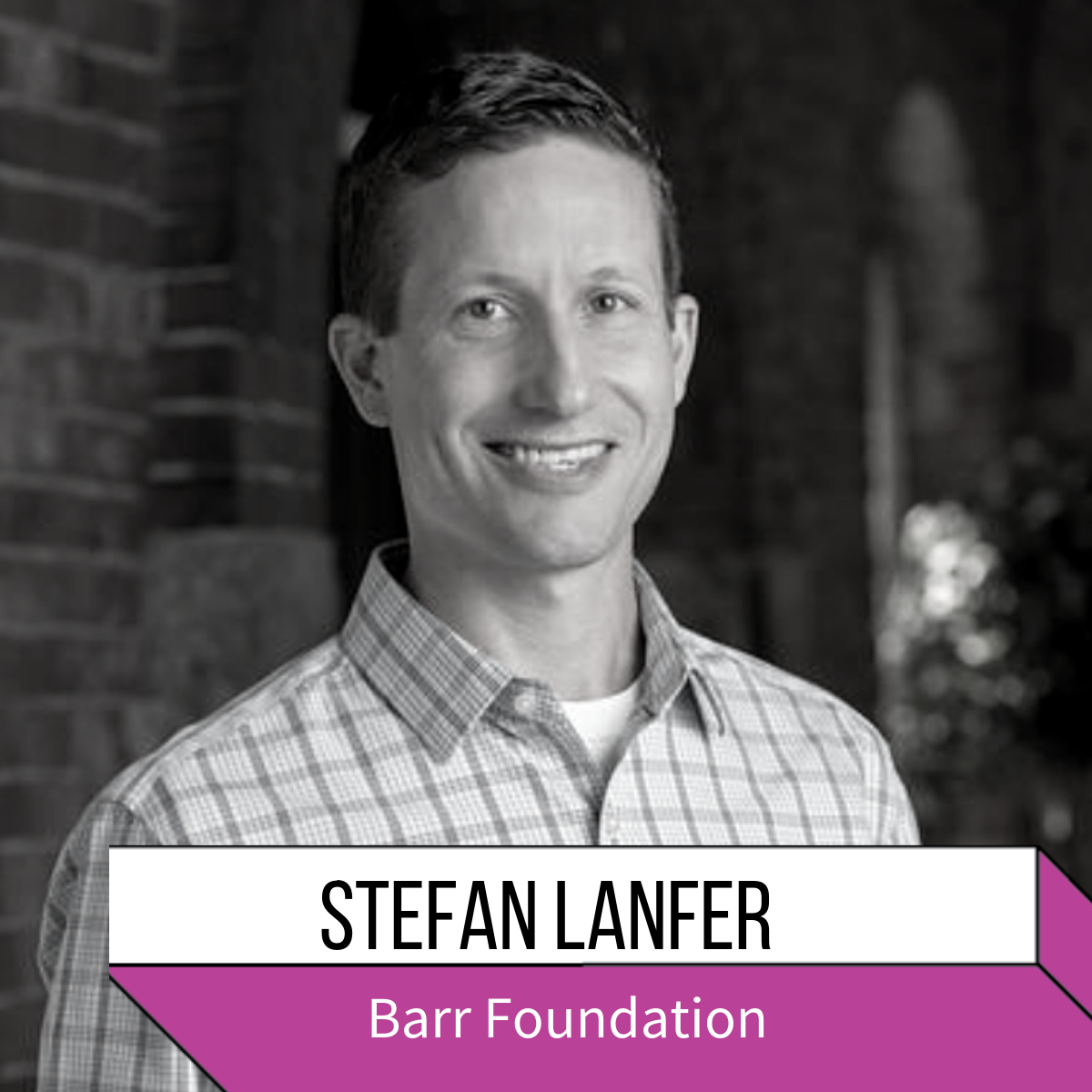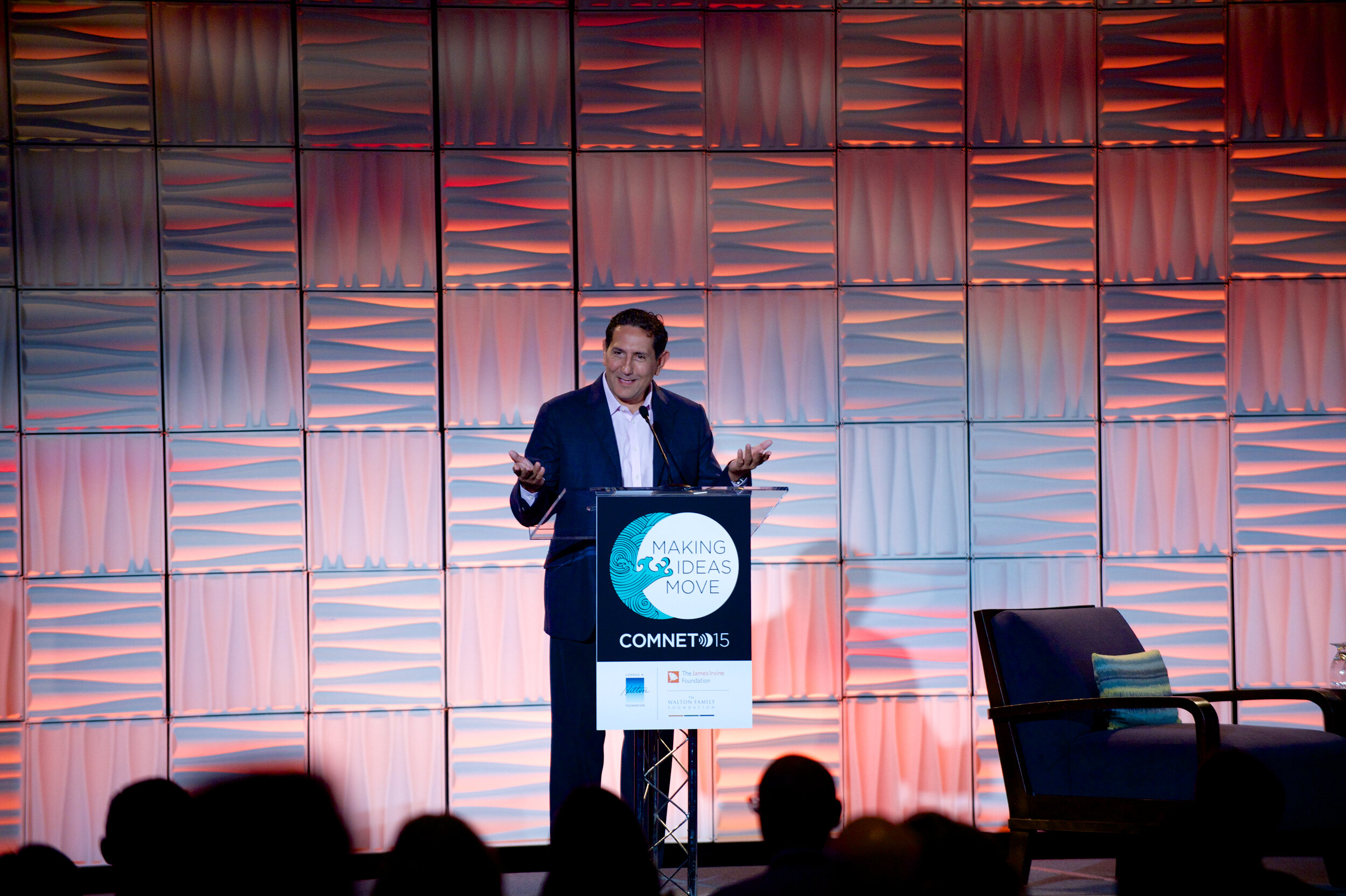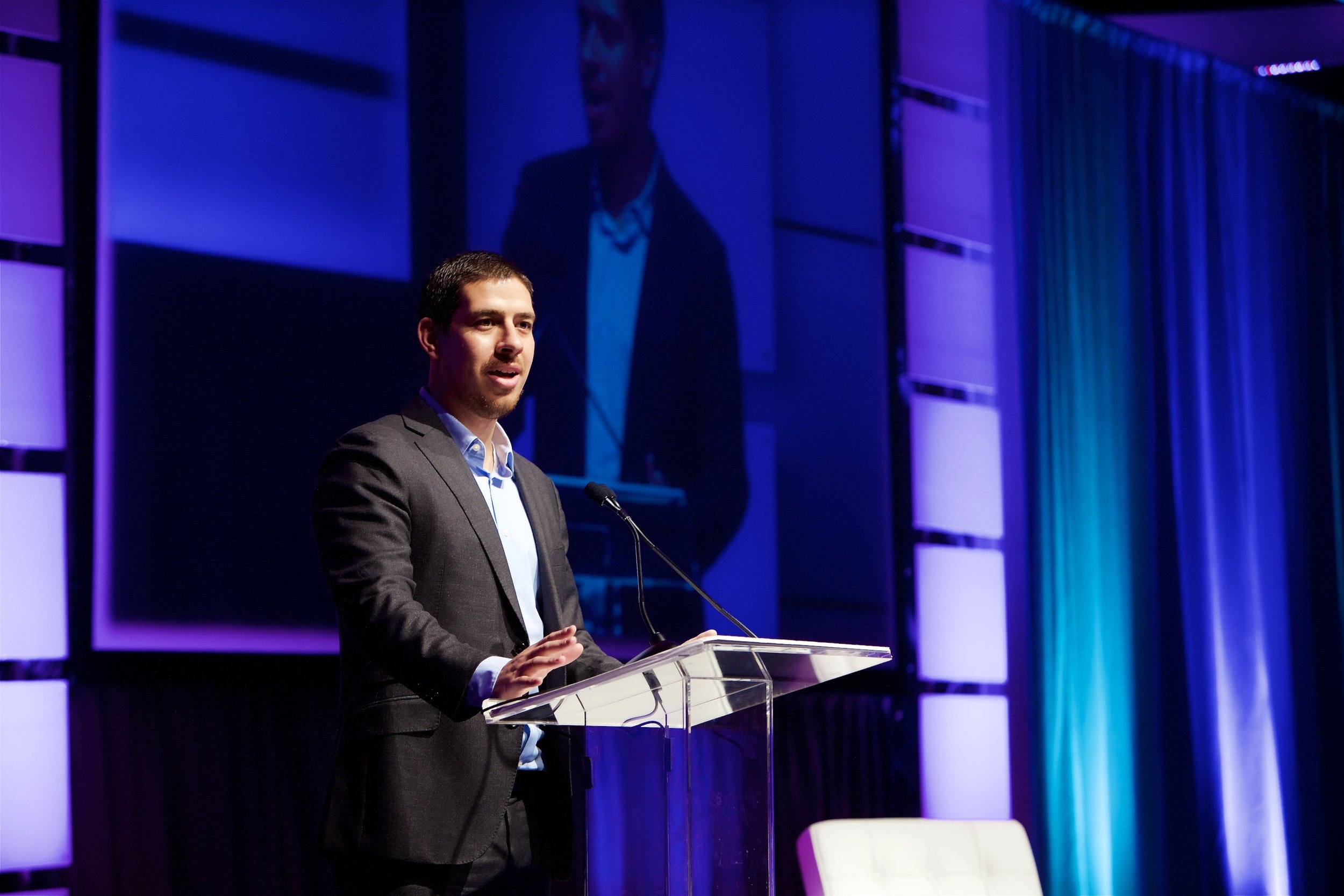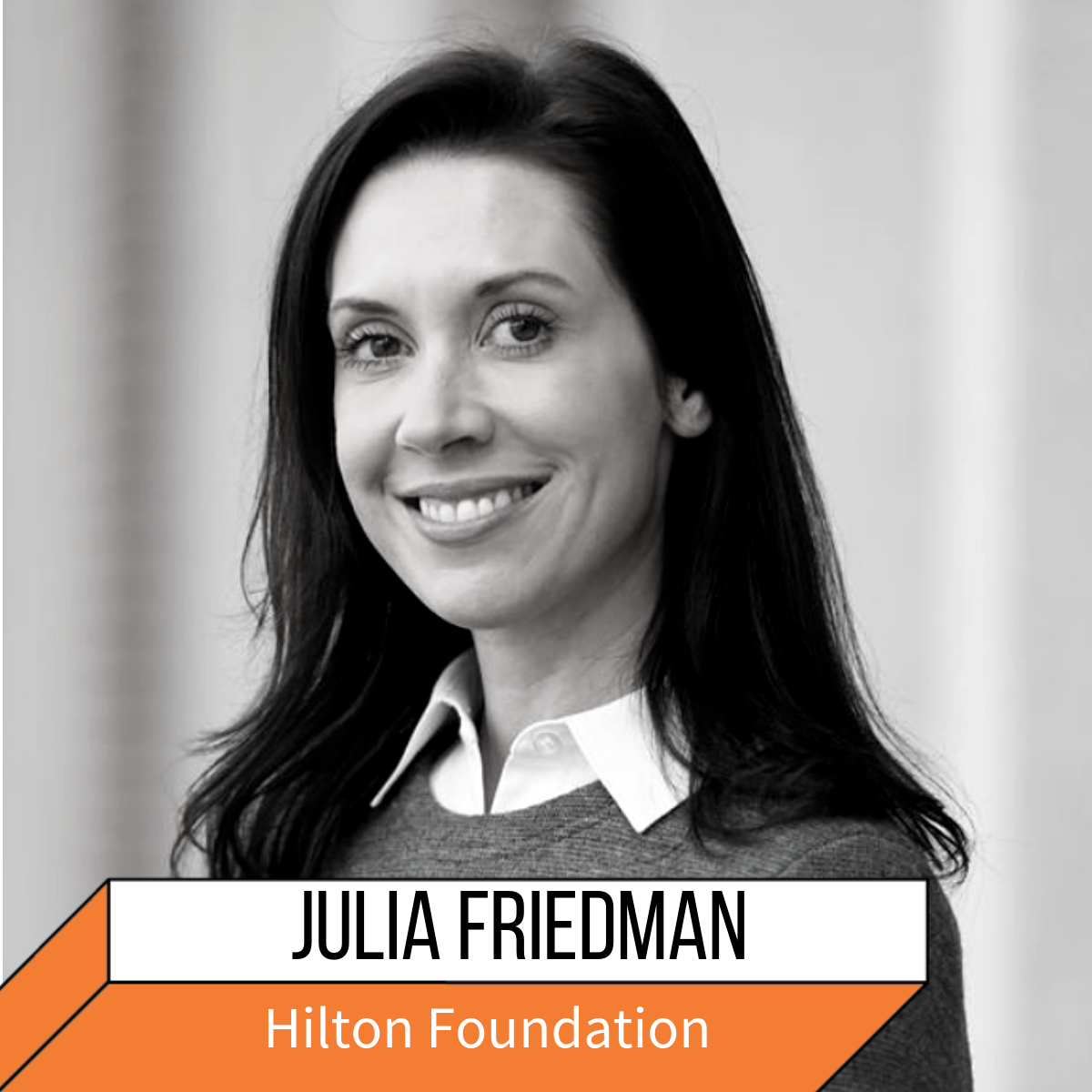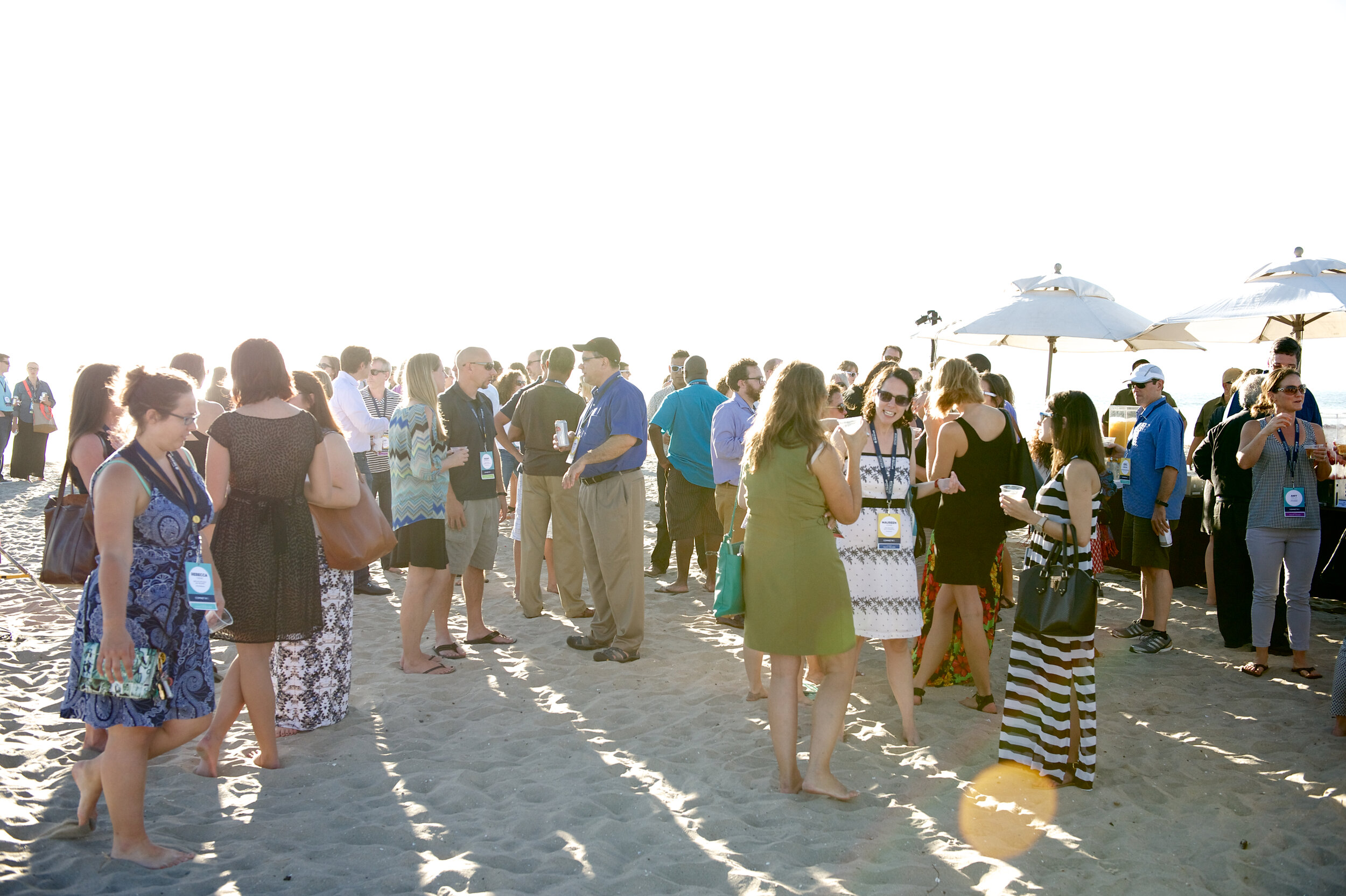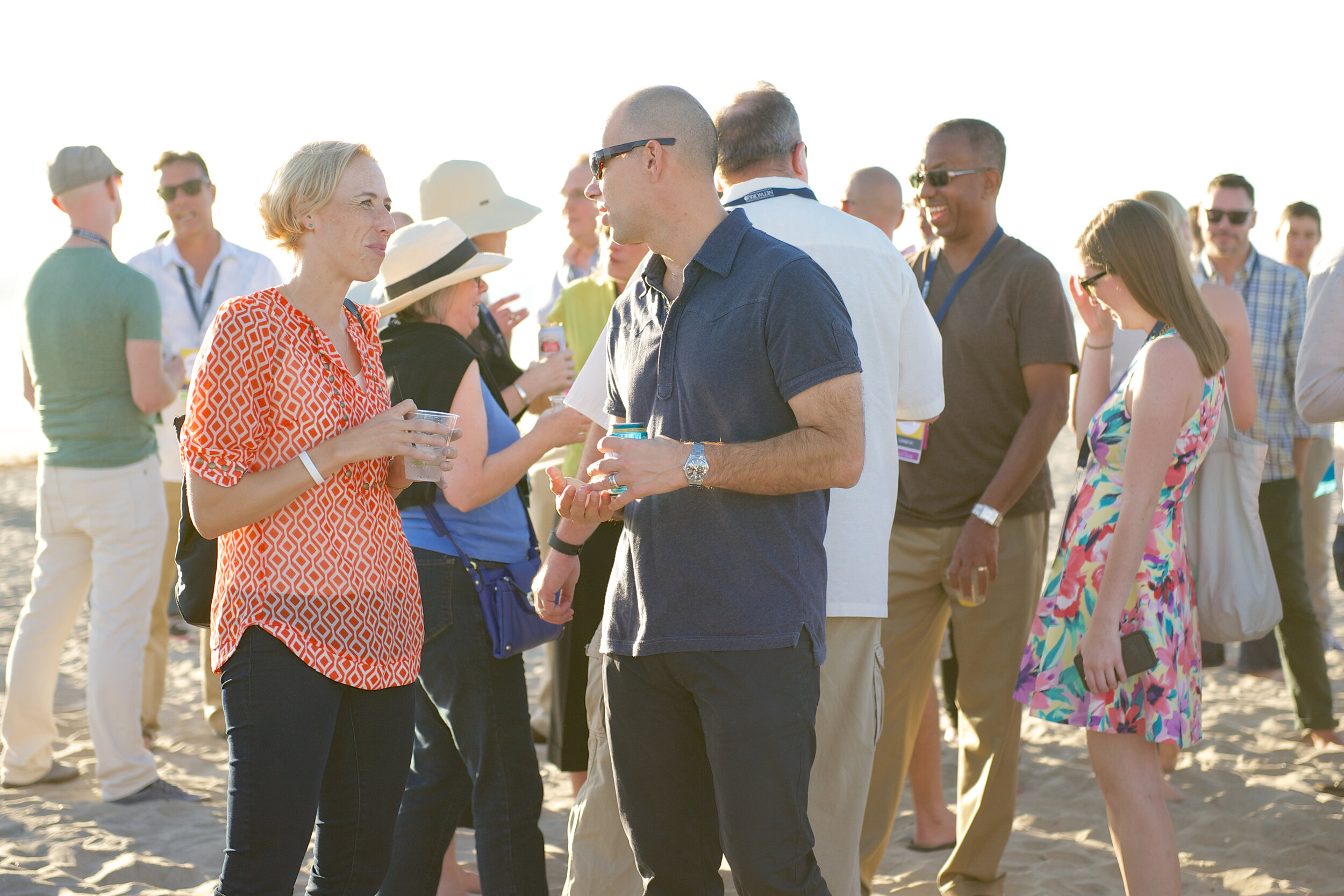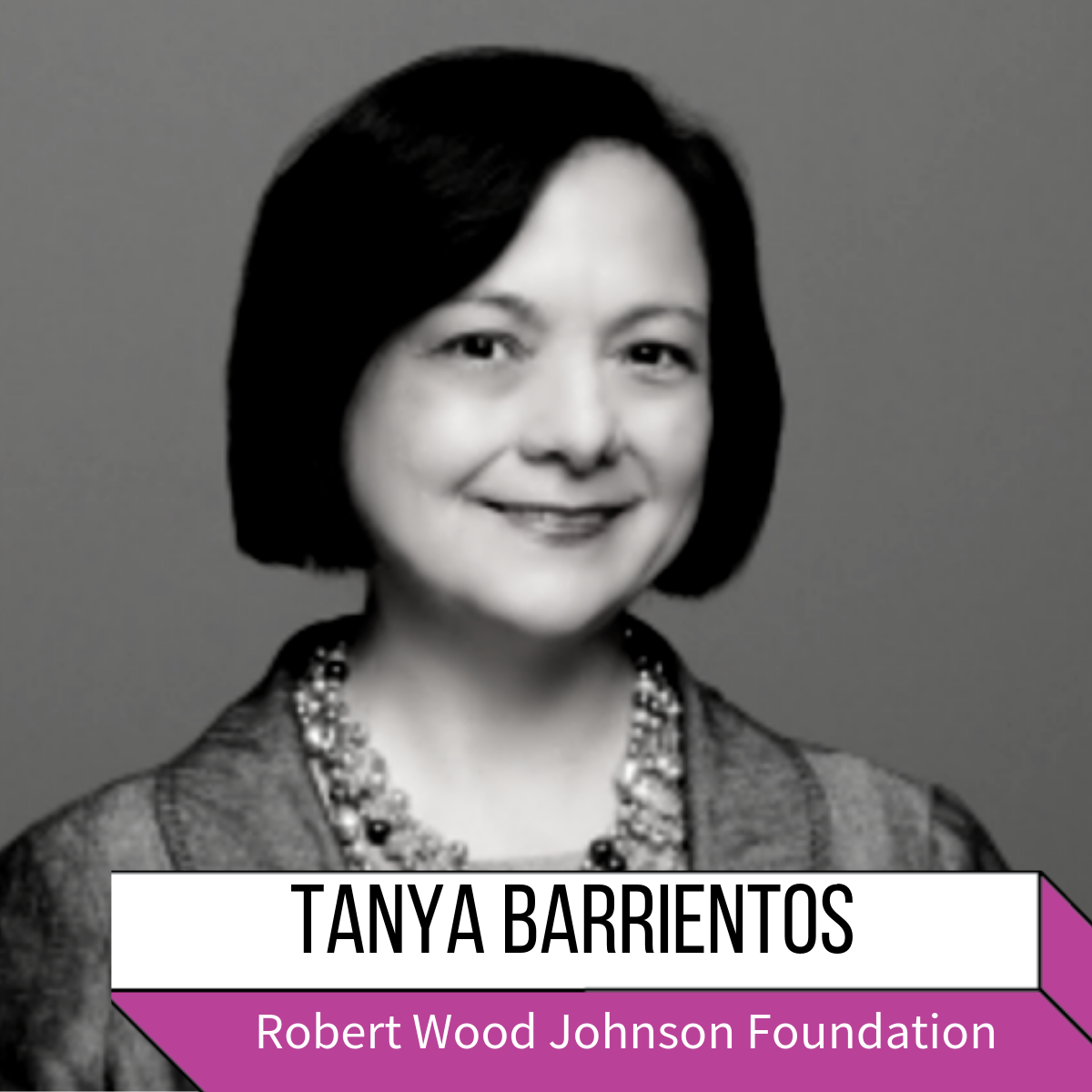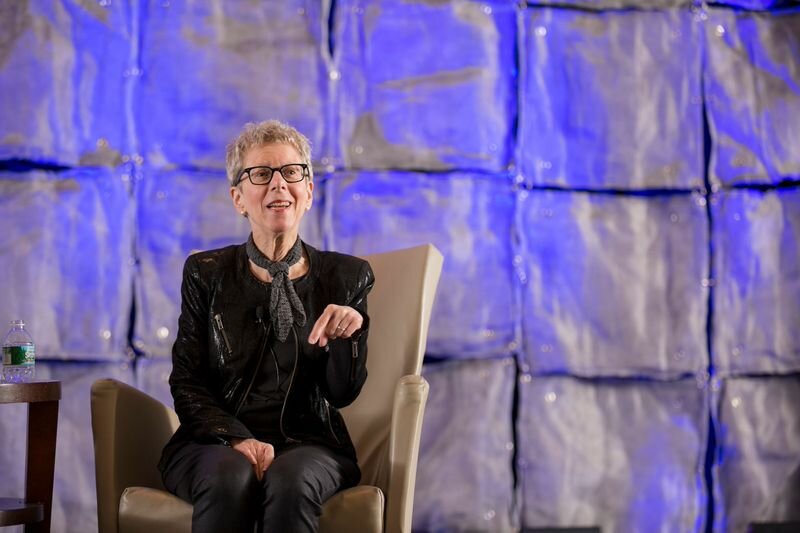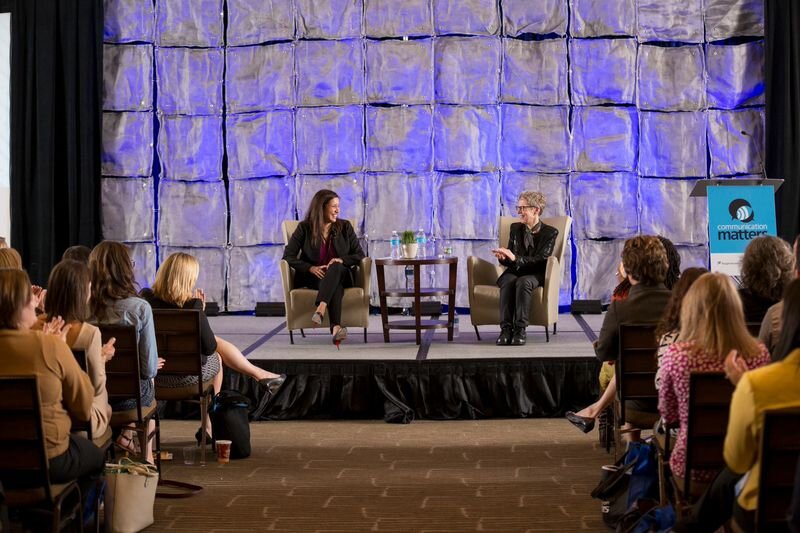MY COMNET STORY
Jill Schwartz, VP of Marketing and Communications, American Forests
Stefan Lanfer, Director of Communications, Barr Foundation
Julia Friedman, Senior Communications Manager, Hilton Foundation
Tanya Barrientos, Director, Executive Communications, Robert Wood Johnson Foundation
LaMonte Guillory, Chief Communications Officer, LOR Foundation
What is ComNet all about? What’s it like? Let me tell you a story…
I put on a sundress and sandals and head down to the beach. It’s the opening night party for ComNet15 in San Diego.
I love parties. I always throw a party for myself on my birthday. I’m the one who organizes the party when a friend moves away. And when she turned 13, I threw my dog a bark mitzvah.
But this ComNet party is different. I don’t know anybody here. Anybody. I’m new to The Communications Network.
In front of me are hundreds of people who are clearly having a lot of fun. I see people getting big hugs. I hear the “Oh my God” screeches when people spot somebody they probably haven’t seen in a while.
It’s the kind of scene I’m familiar with because it plays out at every party I throw.
But in this instance, because I don’t know anybody, I freeze at the edge of the beach. I have just taken off my sandals and added them to the line-up of shoes. But I feel like I can’t get my feet to move.
Suddenly I’m back in junior high, when I am the last one picked for the kickball team. And the softball team. And the dodge ball team. And I’m back at my senior year of high school, when nobody asks me to the prom. These things never made me doubt my self-worth. But they did make me feel like I’m destined to be an outsider.
And I think, “Why am I putting myself back in the same type of situation?”
Honestly, it’s because, at the time, my professional life is in a rut. I’m working hard and producing good work. But not great work. And not much that I think could help me make a difference in the world in the way I desperately want to do.
My work is getting stale. And I know it. And, truthfully, I’m feeling lonely. I’m so busy working that I don’t have time to meet other communicators who, perhaps, could inspire me.
So, when I get an email that mentions the ComNet conference, I ask a colleague about it and she raves about it. She attended a few years earlier and loved it. I’d tried other communications conferences and networking events over the years and found them mostly a waste of time and money. But her enthusiasm makes me want to give ComNet a chance.
A writer from the Daily Show, one of my favorite shows, is one of the keynote speakers. Just about every breakout session seems relevant, interesting and fresh. There is a pre-conference workshop about data visualization, a topic I am trying to learn more about.
So here I am at the ComNet15 opening night reception. I want to disappear, just as the sun is starting to do in front of me. But I take a deep breath…and head over to the bar to order a margarita. It is a strong one.
I haven’t taken more than two sips when a woman walks up to me, smiles and says “Hi!” She wants to know where I live and where I work and what brings me to the conference. Within a few minutes, her friend comes over and the three of us start talking.
And that’s all it takes.
I talk nonstop to people all night. Literally never stop. I only make it to one of the food trucks to grab dinner because I get waylaid so many times along the way. Either people introduce themselves to me or I see something on their name tag that creates an opening for a conversation. Me, who got picked last for kickball, is starting conversations with total strangers!
Not only do I have a great time but I am one of the last people to leave the party. In fact, I don’t even know the party has ended until a friendly cop comes up to the 10 or so of us environmental communicators sitting around a small bonfire. He kindly informs us that it is time to call it a night.
The rest of the week at ComNet15 is a whirlwind. I make new friends during coffee breaks. I meet people seated next to me during breakout sessions. I meet people on the buffet line. It is so easy—I think because we all have something in common. A passion for being strategic communicators for causes we really care about.
ComNet15 pumps life back into me. And I don’t want that feeling to stop, so I leave the conference committed to getting involved in Communications Network events when I get back home.
As I stand in line at the airport, waiting to board my flight to DC, I spot Sean Gibbons in front of me. I’ve never met Sean but was impressed by what I heard from him when he spoke at the conference.
I tap him on the shoulder. In the two seconds it takes him to turn around, I think I shouldn’t have done that. After three days of being the master of ceremonies, he has got to be tired of talking to people. But I also think I should’ve done that. If there’s nothing else I’ve learned during three days at ComNet15, it’s that making connections is important and, in fact, fun. In that moment, I am much more confident about meeting new people then I had been when I landed at that airport three days earlier.
I introduce myself and tell Sean how much I loved the conference. He thanks me – genuinely – and, before I know it, we have plans to meet for coffee in DC. That turns into another coffee meeting. And then a request to join the ComNetDC leadership team. And, not long thereafter, a request to join the Board of Directors.
It’s been the best four years of my communications career. I’ve learned so much about the newest trends in communications. I’ve met a ton of interesting people. I’ve discovered that I have a hidden talent for connecting people.
Thanks to this community we call The Communications Network, I got my communications mojo back.
And I’ve been to some great ComNet parties.
What is ComNet all about? What’s it like? Let me tell you a story…
Thursday, October 4th, 2018.
It is five days before The Communications Network’s big annual conference - ComNet. 2018 is going to be our biggest ever. 1,000 people are registered.
But, on that Thursday, in cities across the country, thousands of hotel workers go on strike - including in San Francisco at the Westin St. Francis Hotel, where we’re headed.
And we don’t have a plan B.
I’m on The Network’s Board. So I know ComNet is our biggest source of revenue. It’s how we keep the lights on, how we pay our staff, and how we advance our mission to serve communications professionals in the social sector.
ComNet18 is also where I’m going to become board chair.
Which is exciting, and an honor, and completely intimidating - the people who preceded me are all so accomplished and impressive. They are my idols and mentors.
I am only a few years into my first job in this field, after a career that has meandered from theatre to education to strategy consulting.
But, they asked me to lead. And, despite doubts I am up to the task, I say, OK.
So, before that Thursday in October, before the strike breaks out, all that summer, my main preoccupation is what I’m going to say when I step onstage in front of 1,000 of my peers, to welcome them to ComNet - something the chair always does.
It is not usually a very memorable part of the proceedings.
Most years, it’s just, Good morning. Welcome. I’m the chair. Communications is still important. And, have a great ComNet.
Then, it’s exit stage left. And the real show starts.
I don’t know. Maybe it’s my theatre background. I keep wondering if there’s another way I can use my time at the podium.
You only get one chance to make a first entrance, right?
One Saturday in July, on a long morning run in Boston, it comes to me:
I see myself onstage and I am not in the typical uniform - the slacks, the open-collar button down, the navy blazer.
I am in a red lycra bodysuit.
Head to toe.
I’ve got the ComNet logo emblazoned on my chest - like Spiderman with the spider.
And my entrance - it’s not just enter stage left.
It is live-action movie, animation, then rock music, as the doors at the back swing open, and I come running up the aisle in the supersuit.
And then I give my speech.
I don’t know. Maybe I run too far that morning. Or don’t drink enough water.
But I can’t shake the idea.
So, I start working on it.
I recruit two of my kids - Drew and Maya, ages 7 and 10 at the time - to help me with the video and the animation. I go underwater with the project for a weekend.
When I’m done, I send it to Sean Gibbons, CEO of The Communications Network.
Am I crazy? I ask.
“Yes,” he says, “and I love it!”
So, I get to work on the speech.
And the days are flying by until Thursday, October 4th, when I get a message in my inbox from Unite Here - the union representing the hotel workers - announcing the strike. They write me. They write Sean. They write every board member, speaker, and sponsor listed on the ComNet website.
They urge us not to meet, eat, or stay at the Westin St. Francis. And to contact management to express our support for the workers.
The strike also hits Boston, where I live.
I ride my bicycle to work every day. My route takes me by two Marriott properties.
When I get to the first - the W - I pull to the curb to take in the scene.
Dozens of hotel workers are marching in front of the entrance.
They’re in red T-shirts with bold black letters on a white background reading, ONE JOB SHOULD BE ENOUGH.
Some bang on orange plastic buckets. Others blow whistles. Someone is leading a chant through a megaphone.
In front of the hotel, an Uber stops. A couple steps out. They get their bags and roll them passed the picket lines, as the workers’ chant becomes:
“Check out!”
Boom boom boom
“Don’t check in!”
Boom boom boom
“Shame on you!”
Boom boom boom
The thought of crossing a picket line like that, or asking our guests to, or climbing into my red lycra bodysuit… It makes my heart sink.
We call an emergency board meeting.
The first Board members to speak up are empathetic with the hotel workers. Several come from organizations focused on poverty, worker’s rights, or immigration. Some are themselves children of immigrants, or of union members, or grew up in poverty. They know the level of sacrifice these workers were making - what it means to live from paycheck to paycheck. And how bad things need to be to put that at risk.
Someone says, we need to get to work exploring alternate sites. A few others agree.
But, we get stuck on the hard reality that the Network has only five staff. It takes them 18 months to plan and execute a conference at this scale.
In these final days, they are already flat out. How could we ask them to do even more?
And then there is our responsibility as fiscal stewards.
Our contract is completely in the hotel’s favor. They would stay open no matter what - hiring temporary workers if need be. If we walked away, we would be on the hook for up to a million dollars. Maybe more. A potentially lethal blow for our small nonprofit.
Maybe, someone suggests, we can find a way to acknowledge and show respect for the workers, even bring their voices onto our stage, but still go forward at the Westin as planned.
Three board members - notably, our three Latino/Latina members - make it clear that, if that is the board’s decision, they’ll support it. But they won’t cross the picket line themselves.
I don’t know what to say.
Maybe, someone suggests, we can create remote gathering places - conference rooms and coffee shops, where attendees who don’t want to cross the picket line can watch the livestream together, and still feel in some way connected.
It was the best idea on the table. The board agrees that Sean will call the host committee together the next morning, to brief them, to get their perspective on the situation on the ground, to test the remote-location idea, and ask for their help.
And then we end the call and hang up.
Right away, my cell phone rings.
It is Jesse Salazar - in his final days as our board chair.
“I am really concerned,” he says.
“So am I,” I say. “What can we do?”
“We need help,” he says. “We need advice.”
Over the next few hours, Jesse and I call trusted colleagues, friends, and mentors.
One former board chair says:
“Picture this: hundreds of nonprofit and foundation leaders cross a picket line where working people are fighting for a living wage and their basic, human dignity. And, once they cross that line, these privileged professionals wine and dine under crystal chandeliers, as they talk about equity and justice. That picture is offensive.”
Another warns us, “If you play this wrong, you’re not only going to lose conference attendees, but speakers, sponsors, funders, board members, and members. The whole thing could come crashing down.”
None of this is particularly reassuring. Or confidence building.
Instead of celebrating our 40th anniversary, am I going to be the board chair who presides over this organization’s demise?
Thankfully, one friend and colleague gives us practical advice:
“Get Sean extra capacity now!”
That night, at 10PM, we call the board together again. We approve $150,000 in emergency funds to hire a crisis communications and logistics team.
Friday morning.
Four days to ComNet.
We hold a conference call with the Host Committee.
After we lay out the situation, the first person to speak is Clarence B. Jones, who was an advisor and speechwriter for Martin Luther King. He helped pen the “I have a Dream” speech.
Dr. Jones was one of our keynote speakers in 2015. And he has kept coming back.
He lives in the Bay Area. And, in 2018, he volunteered with our host committee.
“I love this organization,” says Dr. Jones. “I wish the striking hotel workers could know each of you and the important work you do. I appreciate your wanting to navigate this decision in the right way. You have my support. As for myself, however, I will not be there in the hall with you. It would be sacrilegious to the memory of Dr. King. Given the role that hotel and restaurant workers played in the civil rights movement, I cannot and will not cross this picket line.”
The silence on the line is total.
When others finally speak, their words echo Dr. Jones:
“I won’t cross a picket line.”
“We support you. You can have our conference room. But, we won’t be there.”
Suddenly, it becomes clear - we aren’t just looking at a few conscientious objectors.
If we go ahead, it will be a mass exodus.
After the host committee call, Sean, Jesse, and I get right back on the phone together.
We all know what we have to do - move the conference.
And then, somehow, we do it.
The staff takes it to 11 and works around the clock. The Host Committee, Board members, funders, Network members, first-time ComNet attendees - people step up with creativity, commitment, and this unmistakable joy.
What had taken 18 months of planning is re-built from scratch over the next 48 hours.
By the time people arrive, they find completely different - and amazing - venues. There is catering for 1,000 people. All surrounded by a steady stream of communications with our attendees about what we knew as we knew it, and what it meant for them.
It was incredible.
I always love ComNet.
The people.
The ideas.
The inspiration.
It’s the one conference I make a point of going to every year.
But ComNet18 in San Francisco was unforgettable.
I saw how much more we are than a professional association.
We are a network.
A community.
And I understood why diversity is so critical.
Why we need different perspectives and different life experiences on our board, in leadership, on our staff.
And to have relationships where we can trust each other enough to listen and wrestle through challenging stuff together.
There’s a reason you shouldn’t fill a board entirely with white guys from Greenwich, Connecticut.
Don’t get me wrong. We mean well. We have a good idea now and then.
But, Lord, do we have some blind spots. And to really see and understand, to act with wisdom, compassion, and courage, we need help.
Among other things, it’s the only way I know to be able to zip in to a full lycra bodysuit, and climb onstage before 1,000 colleagues, and give a speech with a clear conscience and a full heart.
Not everyone’s idea of a good time, I know.
But, I loved it. And I got to do it.
What is ComNet all about? What’s it like? Let me tell you a story…
I’ve often heard communications professionals in the world of philanthropy say “we’re not selling toothpaste, we’re using communications to change the world.”
Well, for nearly a decade, I was using communications to sell toothpaste. And video games. And frozen yogurt.
Sure, I had a master’s degree in social work and dreamed of changing the world, but life happens, and I ended up working at PR firms I really did love, although it was not fulfilling my dreams to change the world.
One day, I told myself, I’d make my way back into working in the nonprofit and philanthropy world. I started by jumping into all of the pro bono clients I could get my hands on.
Then, in 2015, my chance finally came. I had an opportunity to join the Communications department at the Conrad N. Hilton Foundation. The Hilton Foundation is a private family foundation working to improve the lives of individuals living in poverty and experiencing disadvantage throughout the world. This was, undoubtedly, the perfect fit. It was my dream job.
But wait! How could I take my knack for selling massive quantities of toothpaste and re-train that muscle to use communications for social good?? Where would I start?
Two weeks into the job, my former boss Marc Moorghen took me to ComNet15 in San Diego.
At first, I was intimidated as I looked around at all of the incredibly intelligent and knowledgeable people who had spent their careers using communications to move the needle on social issues. Some had launched campaigns that resulted in a federal policy change. Some took on big tobacco with the truth campaign, others worked on marriage equality – and here I was, just exiting the toothpaste account. This was a new world for me.
But it didn’t take long for me to realize I was surrounded by people who were not only great communicators, but like me, they also wanted to change the world. Shoeless in the sand on a beach at a ComNet party in San Diego, I said to myself, “These are my people.”
It didn’t take me long to connect with people and establish fast friendships. The shared passions that brought us all to sunny Southern California that year in San Diego brought us back together in Detroit, and then Miami, San Francisco, and now Austin.
When my boss resigned from his position in 2017 to travel the world, I found myself as the interim head of the Hilton Foundation’s Communications department. Still only two years into philanthropy communications, I knew the power of communications to reach the change we seek, but I also knew I couldn’t do it on my own.
I was asked to sit on the hiring committee to find the new head of the Communications department. I know….it’s not typical to have a hand in hiring your own boss. But, I knew they asked me in part because I had learned so much about how communications functioned at so many different foundations, thanks to my colleagues at ComNet.
During that long, 18-month journey, so many in my ComNet family offered to serve as stand-in mentors, resources, guides. I wasn’t walking through this journey alone — but with friends.
With the help of Sean Gibbons and countless other Network members, after a series of listening tours, phone calls and inquiries, I made a case to leadership and our board of directors that what we needed wasn’t a new Director. Instead, we needed a first-ever Vice President of Communications, someone with a literal seat at the table, on equal footing with the program team. Leadership and the board supported my recommendation and in January 2019, Marshall Stowell, our first VP of Communications, joined the Foundation.
No longer the mayonnaise that gives the sandwich flavor, or the gift shop at the end of the museum tour, the Communications team at the Hilton Foundation is now a key ingredient in the cuisine, integrated into the art exhibit. Every day begins with the question: “What can we do today to achieve the change we seek through a partnership between programs and communications?” And that very question has revolutionized the entire organization.
Heading into my fifth ComNet this year, I am amazed at how much I have grown, personally and professionally, thanks to the support of my ComNet colleagues and friends.
It’s been four years since I left corporate PR and jumped into communications for good. I could probably still do a bang-up job selling toothpaste, but I’m grateful that with the help of my communications for good colleagues, I’m finally living my dream to make the world a better place.
What is ComNet all about? What’s it like? Let me tell you a story…
Fred Mann, my boss, poked his head into my office one day, about six months after I started working at the Robert Wood Johnson Foundation. It was one of those drive-by greetings that usually ends with: “OK, have a good day.”
But this time he lingered, half in and half out of the doorway. He smiled and said: “You’re doing a great job, Tanya, and to show my appreciation I’m sending you to the ComNet conference in Philadelphia.”
Now, it’s great to be recognized as a hard worker. And Philadelphia is one of my favorite cities. But my first thought was: “Um, couldn’t you just give me a gift card for coffee?”
Before I became a speechwriter, and before I started working in the communications department of a big, national philanthropy, I was a newspaper reporter. And in the newspaper world, we had a word for people who worked in “communications.” We called them flaks. As in hucksters. As in the Kellyanne Conways of the world.
Now, I know the philanthropy where I work funds important work. And I’ve got nothing against telling people about it. But, to be honest, I never really wanted to completely identify myself as part of the “communications” world.
Besides, I hate conferences. And a conference full of flaks? Dear Lord.
But I had to go. So, I went.
Being new to this whole sector. I didn’t know anybody.
I met a woman in the elevator. She looked at the tag around my neck. She smiled and said she recognized my name from my newspaper days. I smiled back. She told me she had been a newspaper reporter, too, in Baltimore, before working for a philanthropy there. Really? And she said there were lots of former newspaper people doing communications-for-good these days. Really?
She said she’d introduce me around. Hmm, I thought. Maybe this won’t be as bad as I thought.
But I still dreaded the meat of the conference, the keynotes and the breakouts. They’d be all about spin, about deflection, I was sure. And since my boss was attending with me, I knew I couldn’t just hide in the bar.
I opened my welcome packet and took a look at the agenda. One of the keynote speakers was Terry Gross, from NPR’s Fresh Air. Probably the best interviewer in the world. And about as opposite of Kellyanne Conway as you can get.
Lots of the breakout sessions were about using data, research, and evidence to spotlight issues that matter. There was even one about the brain science of storytelling. Sounds interesting. Something a newspaper reporter would even want to know about.
So, I decide to give this thing a chance. And it turned out that I liked every session. Every single one. It was honestly the best conference I’d ever been to. And by the time I left, I was hooked – on The Network itself, and on the conference for certain.
That was back in 2014, and since then I’ve kept in touch with that lady I met in the elevator. We’ve become good colleagues who lean on one another for support and advice. I’ve also built a pretty strong support system with other impressive folks I’ve met over the years — including Dr. Clarence B. Jones, who worked alongside Dr. Martin Luther King Jr., and helped him write his speeches — and I look forward to seeing them every fall.
A few years ago, I was thrilled to be asked to serve on The Communications Network Board, which means that now I have a chance to make sure the conference will always wow any skeptic, like me, who walks through the door
So, here I am today, a complete ComNet convert. And someone who’s become pretty proud to say I work in “communications.”
Flaks? Not so much. At ComNet, we use our powers for social good. And that’s the kind of “communications” I can live with.
I walk up on stage at ComNet 2015 in San Diego, look out at the nearly 600 communications professionals in the audience, and I am nervous as hell. I have never been to this conference, I don’t know anyone here, and I’m not sure if anything I’m going to say is going to make an impact.
On my recommendation, my organization, the LOR Foundation, is sponsoring the opening keynote. LOR had been giving grants for seven years, but people didn’t know who the hell we were, what we did, for who, or why. Getting up on that stage at ComNet was a chance to shine a spotlight onto the rural Mountain West and on the work that we do.
I was given about 5 minutes to address the audience. I was going to introduce renowned journalist Soledad O’Brien, in conversation with Jade Floyd. As I began talking, we launched LOR’s very first website in real time. This was a big deal for me and for LOR, and I could feel the pressure.
I was passionate about the work I was doing, but I wasn’t sure if these people would get it, would get me. But I’m not one to rest on my laurels. After my moment in the spotlight, in true LaMonte fashion, I walked around the conference halls introducing myself and meeting new people. I really felt like I was at home, like this group of people was genuine and sincere in advancing and talking about the value of comms. ComNet was my kind of place!
At the end of that first day, Civil Rights Movement legend Dr. Clarence B. Jones spoke. This was the man who helped draft Dr. Martin Luther King Jr.’s “I Have a Dream” speech, and is the namesake for ComNet’s Jones Award. When he spoke, I got chills. I don’t think I even blinked. He made me feel Iike what we were doing as professionals in elevating comms was, in essence, changing the world.
Part of his speech focused on the “Black Lives Matters” movement, which was just starting to take form and grab headlines. He talked about the injustices leveled against black people, particularly black men. As a person of color, that resonated with me as well. At the time my son may have been 5 years old. Dr. Jones made me realize that next time it could be my son shot down innocently just because he was black. Now, I’m in a bi-racial marriage, my kids are bi-racial, and when they started hearing about Black Lives Matter, they would ask, “Don’t all lives matter?”
At the end of the presentation, the audience was invited to ask Dr. Jones questions. I raised my hand nervously and asked Dr. Jones what I should be telling my children when they ask about whether “all lives matter.”
“If black lives don’t matter, then no lives matter,” he told me. “If you can’t respect one race, then all races don’t matter. Sure, all lives matter, but my black life matters right now.” And that stopped me dead in my tracks.
Because it made me realize that living in a mostly white community, I sometimes forget that I'm a black man. And yet, on a deeper level I’m keenly aware that for most of my friends and neighbors, I am the black representation of the entire race. When I walk out of the door, I represent the entire culture. So unconsciously, I feel I always have to be at my best. I have to navigate this landscape with precision. Listening to Dr. Jones made me realize I have a responsibility as a black man and so f—king what if I constantly have to be on my game, if I am in a position to elevate what people might think of black men.
When I went home, because of Dr. Jones, for the first time I felt I had a good answer for my children when they asked me about the Black Lives Matter movement.
My daughter looks more black than my son, and she struggles sometimes with her identity. She knows other kids view her as different. They pat her hair and treat her differently. I hope I was able to channel Dr. Jones’ passion about how black people were being marginalized and persecuted just because they were black, and that the “Black Lives Matters” movement was fighting for fairness, access, and justice. It’s my hope that talking to her about Dr. Jones’ speech and opening the lines of communication around this issue will help her find her comfort lane in straddling her multiracial background.
Riding the wave from ComNet San Diego, LOR hosted the following year’s opening night reception in Detroit and then again in Miami. We’ve successfully leveraged this annual conference as a way to continually elevate LOR, the Mountain West, and me as a resource within the sector. The Communications Network has one of the best platforms for sharing, learning, elevating, and networking.
But more importantly, just like that first trip to San Diego, I leave every conference inspired. And amazed by the power of great communication.


